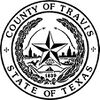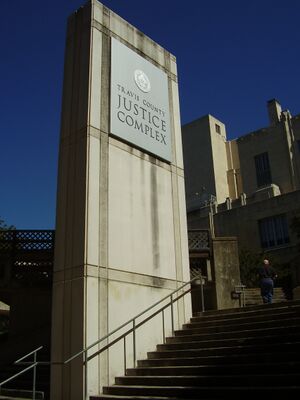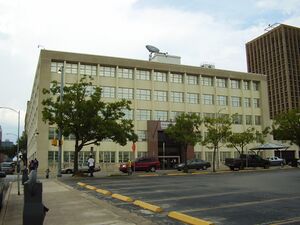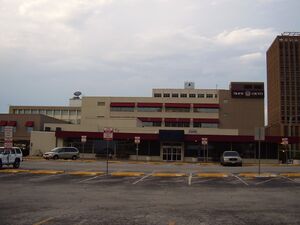مقاطعة تراڤس، تكساس
Travis County | |
|---|---|
County | |
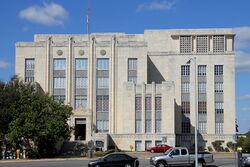 | |
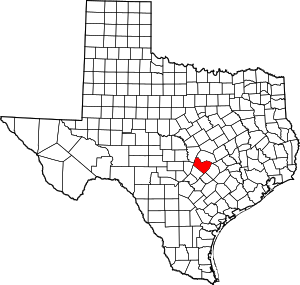 الموقع ضمن ولاية Texas | |
 موقع Texas ضمن الولايات المتحدة | |
| الإحداثيات: 30°20′N 97°47′W / 30.33°N 97.78°W | |
| البلد | |
| State | |
| تأسست | 1840 |
| السمِيْ | William B. Travis |
| Seat | Austin |
| Largest city | Austin |
| المساحة | |
| • الإجمالي | 1٬023 ميل² (2٬650 كم²) |
| • البر | 990 ميل² (2٬600 كم²) |
| • الماء | 33 ميل² (90 كم²) 3.2% |
| التعداد (2020) | |
| • الإجمالي | 1٬290٬188 |
| • الكثافة | 1٬300/sq mi (490/km2) |
| منطقة التوقيت | UTC−6 (Central) |
| • الصيف (التوقيت الصيفي) | UTC−5 (CDT) |
| Congressional districts | 10th، 17th، 21st، 25th، 35th |
| الموقع الإلكتروني | traviscountytx |
مقاطعة تراڤيس إنگليزية: Travis County هي إحدى المقاطعات في ولاية تكساس، الولايات المتحدة. As of the 2020 census, the population was 1,290,188. It is the fifth-most populous county in Texas. Its county seat is Austin,[1] the capital of Texas. The county was established in 1840 and is named in honor of William Barret Travis, the commander of the Republic of Texas forces at the Battle of the Alamo. Travis County is part of the Austin–Round Rock Metropolitan Statistical Area. It is located along the Balcones Fault, the boundary between the Edwards Plateau to the west and the Blackland Prairie to the east.
. . . . . . . . . . . . . . . . . . . . . . . . . . . . . . . . . . . . . . . . . . . . . . . . . . . . . . . . . . . . . . . . . . . . . . . . . . . . . . . . . . . . . . . . . . . . . . . . . . . . . . . . . . . . . . . . . . . . . . . . . . . . . . . . . . . . . . . . . . . . . . . . . . . . . . . . . . . . . . . . . . . . . . . .
التاريخ
Pre-Columbian and colonial periods
Evidence of habitation of the Balcones Escarpment region of Texas can be traced to at least 11,000 years ago. Two of the oldest Paleolithic archeological sites in Texas, the Levi Rock Shelter and Smith Rock Shelter, are in southwest and southeast Travis County, respectively.[2] Several hundred years before European settlers arrived, a variety of nomadic Native American tribes inhabited the area. These indigenous peoples fished and hunted along the creeks, including present-day Barton Springs,[3] which proved to be a reliable campsite.[4] At the time of the first permanent settlement of the area, the Tonkawa tribe was the most common, with the Comanches and Lipan Apaches also frequenting the area.[5]
The region (along with all of modern Texas) was claimed by the Spanish Empire in the 1600s, but at the time no attempt was made to settle the area (or even to fully explore it).[6] In 1691 Domingo Terán de los Ríos made an inspection tour through East Texas that likely took him through Travis Country. The first European settlers in the area were a group of Spanish friars who arrived from East Texas in July 1730. They established three temporary missions, La Purísima Concepción, San Francisco de los Neches and San José de los Nazonis, on a site by the Colorado River near Barton Springs. The friars found conditions undesirable and relocated to the San Antonio River within a year of their arrival.[7]
Mexican period
In 1821 Mexico won its independence from Spain, and the new government enacted laws encouraging colonists to settle the Texas frontier by granting them land and reduced taxation. Over the next decade, thousands of foreign immigrants (primarily from the United States) moved into Texas; in particular, American empresario Stephen F. Austin established one of his colonies near what is now Bastrop, Texas (in future Travis County) in 1827.[8] Josiah and Mathias Wilbarger, Reuben Hornsby, Jacob M. Harrell, and John F. Webber were early settlers who moved into the area in the early 1830s.
Republican period
In 1836 Texas declared and won its independence from Mexico, forming a new Republic of Texas. After Texas Vice President Mirabeau B. Lamar visited central Texas during a buffalo-hunting expedition between 1837 and 1838, he proposed that the republic's capital (then located in Houston) be relocated to a site on the north bank of the Colorado River. In 1839 the site was officially chosen as the republic's new capital and given the name Waterloo, Texas; shortly thereafter the city's name was changed to Austin in honor of Stephen F. Austin.[9] A new county was also established the following year, of which Austin would be the seat; the county was named Travis County, after William B. Travis. Though the Republic's capital moved briefly back to Houston during the events surrounding the Texas Archive War, by 1845 Austin was again the capital, and it became the capital of the new State of Texas when Texas was annexed by the United States later that year.
Civil War and beyond
In 1861 Travis County was one of the few Texas counties to vote against secession from the Union. Since the majority of the state did favor secession, Travis County then became a part of the Confederacy for the duration of the Civil War. After the Confederacy's defeat, Texas was fully readmitted to the Union in 1870.
From the end of the Civil War to the early twenty-first century, Travis County has experienced steady, rapid population growth (averaging more than a 36% increase every decade from 1870 to 2010), driven largely by the growth of Austin and its suburbs; it is now the fifth most populous county in Texas, after Harris (Houston), Dallas, Tarrant (Fort Worth) and Bexar (San Antonio) counties.
الجغرافيا
According to the U.S. Census Bureau, the county has a total area of 1,023 square miles (2,650 km2), of which 990 square miles (2,600 km2) is land and 33 square miles (85 km2) (3.2%) is water.[10] Travis County is located in the southern part of central Texas, between San Antonio and Dallas–Fort Worth. The county's geographical center lies two miles northwest of downtown Austin at 30°18' north latitude and 97°45' west longitude.[11]
Travis County straddles the Balcones Fault, the boundary between the Edwards Plateau to the west and the Texas Coastal Plain to the east. The western part of the county is characterized by the karst topography of the Texas Hill Country, while the eastern part exhibits the fertile plains and farmlands of the Blackland Prairie. The Colorado River meanders through the county from west to east, forming a series of man-made lakes (Lake Travis, Lake Austin, and Lady Bird Lake).
العيون
The limestone karst geology of the western and southwestern parts of Travis County gives rise to numerous caverns and springs, some of which have provided shelter and water for humans in the region for thousands of years. Notable springs in the county include Barton Springs, Deep Eddy and Hamilton Pool.
الطرق الرئيسية
Travis County is crossed by Interstate Highway 35, US Highways 183 and 290, and Texas Highway 71. IH-35 leads northward to Waco and Dallas–Fort Worth and southward to San Antonio. US-183 leads northward through Cedar Park to Lampasas and southward to Lockhart. US-290 leads westward to Fredericksburg and eastward to Houston. TX-71 leads westward to Marble Falls and eastward to Bastrop.
Other major highways within the county include Texas Highway Loop 1 (the "Mopac Expressway"), which runs from north to south through the center of the county, and Texas Highway 45, which forms parts of an incomplete highway loop around Austin. Texas Highway 130 (constructed as an alternative to IH-35 for long-distance traffic wishing to avoid Austin and San Antonio) also runs from north to south through the sparsely populated eastern part of the county.
المقاطعات المجاورة
- Williamson County (north)
- Bastrop County (east)
- Caldwell County (south)
- Hays County (southwest)
- Blanco County (west)
- Burnet County (northwest)
الأماكن المحمية
الديمغرافيا
| التعداد التاريخي | |||
|---|---|---|---|
| التعداد | Pop. | %± | |
| 1850 | 3٬138 | — | |
| 1860 | 8٬080 | 157٫5% | |
| 1870 | 13٬153 | 62٫8% | |
| 1880 | 27٬028 | 105٫5% | |
| 1890 | 36٬322 | 34٫4% | |
| 1900 | 47٬386 | 30٫5% | |
| 1910 | 55٬620 | 17٫4% | |
| 1920 | 57٬616 | 3٫6% | |
| 1930 | 77٬777 | 35�0% | |
| 1940 | 111٬053 | 42٫8% | |
| 1950 | 160٬980 | 45�0% | |
| 1960 | 212٬136 | 31٫8% | |
| 1970 | 295٬516 | 39٫3% | |
| 1980 | 419٬573 | 42�0% | |
| 1990 | 576٬407 | 37٫4% | |
| 2000 | 812٬280 | 40٫9% | |
| 2010 | 1٬024٬266 | 26٫1% | |
| 2020 | 1٬290٬188 | 26�0% | |
| U.S. Decennial Census[12] 1850–2010[13] 2010–2019[14] | |||
Per 2018 US Census Bureau projections, the population of the county was 1,227,771; demographically 73.53% White, 8.32% Black, 7.53% other races, and 33.87% Hispanic.[15]
. . . . . . . . . . . . . . . . . . . . . . . . . . . . . . . . . . . . . . . . . . . . . . . . . . . . . . . . . . . . . . . . . . . . . . . . . . . . . . . . . . . . . . . . . . . . . . . . . . . . . . . . . . . . . . . . . . . . . . . . . . . . . . . . . . . . . . . . . . . . . . . . . . . . . . . . . . . . . . . . . . . . . . . .
2000 Census
According to the census of 2000, there were 812,280 people, of which 29.30% had children under the age of 18 living with them, 42.60% were married couples living together, 10.40% had a female householder with no husband present, and 42.70% were non-families. 30.10% of all households were composed of individuals, and 4.40% had someone living alone who was 65 or older. The average household size was 2.47 and the average family size was 3.15. 12.0% were of German, 7.7% English, 6.6% Irish and 5.5% American ancestry according to Census 2000[16]
The population's age distribution was 23.80% under the age of 18, 14.70% from 18 to 24, 36.50% from 25 to 44, 18.20% from 45 to 64, and 6.70% age 65 years of age or older. The median age was 30 years. For every 100 females, there were 104.90 males. For every 100 females age 18 and over, there were 104.50 males.
الحكومة والبنية التحتية
Like other Texas counties, Travis County is governed by a Commissioners' Court composed of the county judge and four county commissioners. The court levies county taxes and sets the budgets for county officials and agencies. The judge and commissioners are elected for four-year terms (the judge at-large, and the commissioners from geographic precincts). The other major county-wide official is the county clerk, who maintains the county's records, administers elections, and oversees legal documentation (such as property deeds, marriage licenses and assumed name certificates). The clerk is also elected at-large for a four-year term.
The Heman Marion Sweatt Travis County Courthouse is located in downtown Austin. The county courthouse holds civil and criminal trial courts and other functions of county government. اعتبارا من 2017[تحديث], the county's probate courts are in the process of being moved from the county courthouse into Austin's 1936 United States Courthouse, which was acquired by the county in 2016.[17]
الاقتصاد
As of 2017, Travis County had a median household income of $68,350 per year, and a per capita income of $38,820 per year. 13.9% of the population lived below the poverty level.[14] The county's largest employers are governments (the State of Texas, the US Federal Government, Travis County and the City of Austin) and public education bodies. Other major employers are concentrated in industries relating to semiconductors, software engineering and healthcare.[18]
Travis County, along with other Texas counties, has one of the nation's highest property tax rates. In 2009, the county was ranked 88th in the nation for property taxes as percentage of the homes value on owner-occupied housing.[19] Travis County also ranked in the top 100 for amount of property taxes paid and for percentage of income paid as tax. Property tax rates are generally high in Texas because the state does not levy an income tax.
السياسة
Travis County is one of the most consistently Democratic counties in Texas, having voted for the Democratic presidential nominee in twelve of the last fifteen elections since 1960. The only exceptions have been the Republican landslide years of 1972 and 1984, when Richard Nixon and Ronald Reagan each won 49 out of 50 states, and 2000, when the Republican nominee was incumbent Texas Governor George W. Bush. In 2005 Travis County was the only county in Texas to vote against the Proposition 2 state constitutional amendment banning gay marriage, with slightly under 60% of voters being against it.[20] In 2020, Travis County backed Democrat Joe Biden with nearly 72% of the vote, which was the highest percentage he received in any Texas county, and the largest percentage received by any winner of the presidential election in the county since 1948.
The county's Democratic advantage is not limited to the presidential level, as all of the county-level officials and state representatives are Democrats.[21]
| السنة | الجمهوري | الديمقراطي | حزب ثالث | |||
|---|---|---|---|---|---|---|
| رقم. | % | رقم. | % | رقم. | % | |
| 2020 | 161,337 | 26٫43% | 435,860 | 71٫41% | 13,152 | 2٫15% |
| 2016 | 127,209 | 27٫14% | 308,260 | 65٫77% | 33,251 | 7٫09% |
| 2012 | 140,152 | 36٫21% | 232,788 | 60٫14% | 14,117 | 3٫65% |
| 2008 | 136,981 | 34٫25% | 254,017 | 63٫52% | 8,890 | 2٫22% |
| 2004 | 147,885 | 42�00% | 197,235 | 56٫01% | 6,993 | 1٫99% |
| 2000 | 141,235 | 46٫88% | 125,526 | 41٫67% | 34,502 | 11٫45% |
| 1996 | 98,454 | 39٫97% | 128,970 | 52٫36% | 18,877 | 7٫66% |
| 1992 | 88,105 | 31٫89% | 130,546 | 47٫26% | 57,584 | 20٫85% |
| 1988 | 105,915 | 44٫86% | 127,783 | 54٫13% | 2,386 | 1٫01% |
| 1984 | 124,944 | 56٫84% | 94,124 | 42٫82% | 745 | 0٫34% |
| 1980 | 73,151 | 45٫69% | 75,028 | 46٫87% | 11,914 | 7٫44% |
| 1976 | 71,031 | 46٫67% | 78,585 | 51٫63% | 2,597 | 1٫71% |
| 1972 | 70,561 | 56٫30% | 54,157 | 43٫21% | 611 | 0٫49% |
| 1968 | 34,309 | 41٫58% | 39,667 | 48٫07% | 8,544 | 10٫35% |
| 1964 | 19,838 | 31٫02% | 44,058 | 68٫89% | 62 | 0٫10% |
| 1960 | 22,107 | 44٫87% | 27,022 | 54٫85% | 135 | 0٫27% |
| 1956 | 23,551 | 53٫98% | 19,982 | 45٫80% | 98 | 0٫22% |
| 1952 | 20,850 | 52٫06% | 19,155 | 47٫83% | 46 | 0٫11% |
| 1948 | 5,994 | 22٫03% | 19,598 | 72٫03% | 1,615 | 5٫94% |
| 1944 | 2,324 | 12٫09% | 14,384 | 74٫80% | 2,522 | 13٫11% |
| 1940 | 3,128 | 15٫26% | 17,300 | 84٫38% | 75 | 0٫37% |
| 1936 | 1,154 | 8٫60% | 12,092 | 90٫07% | 179 | 1٫33% |
| 1932 | 1,532 | 11٫45% | 11,718 | 87٫60% | 126 | 0٫94% |
| 1928 | 4,847 | 51٫83% | 4,487 | 47٫98% | 17 | 0٫18% |
| 1924 | 1,909 | 19٫43% | 7,573 | 77٫06% | 345 | 3٫51% |
| 1920 | 1,204 | 20٫39% | 3,541 | 59٫97% | 1,160 | 19٫64% |
| 1916 | 690 | 15٫47% | 3,682 | 82٫54% | 89 | 2�00% |
| 1912 | 468 | 12٫04% | 2,741 | 70٫54% | 677 | 17٫42% |
. . . . . . . . . . . . . . . . . . . . . . . . . . . . . . . . . . . . . . . . . . . . . . . . . . . . . . . . . . . . . . . . . . . . . . . . . . . . . . . . . . . . . . . . . . . . . . . . . . . . . . . . . . . . . . . . . . . . . . . . . . . . . . . . . . . . . . . . . . . . . . . . . . . . . . . . . . . . . . . . . . . . . . . .
حكومة المقاطعة
Travis County elected officials
| Position | Name | Party | |
|---|---|---|---|
| County Judge | Andy Brown | Democratic | |
| Commissioner, Precinct 1 | Jeff Travillion | Democratic | |
| Commissioner, Precinct 2 | Brigid Shea | Democratic | |
| Commissioner, Precinct 3 | Ann Howard | Democratic | |
| Commissioner, Precinct 4 | Margaret Gómez | Democratic | |
| County Attorney | Delia Garza | Democratic | |
Communities
Cities (multiple counties)
- Austin (county seat) (small parts in Hays and Williamson counties)
- Cedar Park (mostly in Williamson County)
- Elgin (mostly in Bastrop County)
- Leander (mostly in Williamson County)
- Mustang Ridge (small parts in Caldwell and Bastrop counties)
- Pflugerville (small part in Williamson County)
- Round Rock (mostly in Williamson County)
المدن
القرى
Census-designated places
- Anderson Mill (former)
- Barton Creek
- Garfield
- Hornsby Bend
- Hudson Bend
- Jollyville (former)
- Lost Creek
- Manchaca
- Onion Creek (former)
- Shady Hollow
- Steiner Ranch
- Wells Branch
- Windemere (former)
Other unincorporated communities
انظر أيضاً
- Austin Bat Cave (non-profit educational org)
- List of museums in Central Texas
- National Register of Historic Places listings in Travis County, Texas
- Recorded Texas Historic Landmarks in Travis County
المراجع
- ^ "Find a County". National Association of Counties. Retrieved March 26, 2020.
- ^ Hester, Thomas (1986). "The Balcones Escarpment: Early Human Populations". Geological Society of America. Abbott, Patrick L. and Woodruff, C. M. 6 (2): 55–62. Archived from the original on October 12, 2011. Retrieved September 6, 2011.
- ^ "Austin Public Library". Austin Public Library. Archived from the original on 8 August 2007. Retrieved 20 March 2018.
- ^ "Austin Public Library". Austin Public Library. Retrieved 20 March 2018.
- ^ "Austin Public Library". Austin Public Library. Archived from the original on 5 October 2001. Retrieved 20 March 2018.
- ^ Chipman, Donald E. (1992), Spanish Texas, 1519–1821, Austin, Texas: University of Texas Press, p. 26, ISBN 0-292-77659-4
- ^ "The Spanish Missions in Texas". Texas Almanac. Texas State Historical Association. Retrieved September 10, 2011.
- ^ de la Teja, Jesus F. (1997). "The Colonization and Independence of Texas: A Tejano Perspective". In Rodriguez O., Jaime E.; Vincent, Kathryn (eds.). Myths, Misdeeds, and Misunderstandings: The Roots of Conflict in U.S.–Mexican Relations. Wilmington, DE: Scholarly Resources Inc. p. 88. ISBN 0-8420-2662-2.
- ^ "Austin Public Library". Austin Public Library. Retrieved 20 March 2018.
- ^ "2010 Census Gazetteer Files". United States Census Bureau. August 22, 2012. Retrieved May 11, 2015.
- ^ Smyrl, Vivian Elizabeth (15 June 2010). "TRAVIS COUNTY". Handbook of Texas Online. Texas State Historical Association. Retrieved 18 April 2015.
- ^ "U.S. Decennial Census". United States Census Bureau. Retrieved May 11, 2015.
- ^ "Texas Almanac: Population History of Counties from 1850–2010" (PDF). Texas Almanac. Retrieved May 11, 2015.
- ^ أ ب "U.S. Census website". United States Census Bureau. July 1, 2018. Retrieved June 8, 2019.
- ^ US Census 2018 ACS 5-Year Study, United States Census Bureau, 2019-07-01, https://www.census.gov, retrieved on 2019-12-25
- ^ Leonhardt, David; Quealy, Kevin (June 26, 2015), "Where Same-Sex Couples Live", The New York Times, https://www.nytimes.com/2015/06/27/upshot/supreme-court-gay-marriage-ruling-where-same-sex-couples-live.html?_r=0&abt=0002&abg=0, retrieved on July 6, 2015
- ^ Goldenstein, Taylor (December 29, 2016). "Travis County gets old federal courthouse for probate court expansion". Austin American-Statesman. Retrieved December 4, 2017.
- ^ "Major Employers". Austin Chamber of Commerce. Retrieved 20 April 2015.
- ^ "Property Taxes on Owner-Occupied Housing by County, 2005 - 2009, Ranked by Taxes as Percentage of Home Value (One year averages)". Tax Foundation. 2010-09-28. Retrieved 2013-07-10.
- ^ Burka, Paul (January 2006). "The M Word". Texas Monthly. Retrieved 2020-04-07.
Of course, I live in Travis County, the only county to vote down Prop 2. [...] Travis voted just a tick short of 60 percent against it.
- ^ https://countyclerk.traviscountytx.gov/images/pdfs/pdf_tc_elections_2019-20_Elected_OfficialsU.pdf
- ^ Leip, David. "Dave Leip's Atlas of U.S. Presidential Elections". uselectionatlas.org. Retrieved 20 March 2018.
وصلات خارجية
- Travis County Government website
- Travis County from the Handbook of Texas Online
- Travis County, Texas at the Open Directory Project

|
Williamson County | Burnet County | 
| |
| Bastrop County | Blanco County | |||
| Caldwell County | Hays County |
- Pages using gadget WikiMiniAtlas
- Short description is different from Wikidata
- Coordinates on Wikidata
- مقاطعات Texas
- Pages using infobox U.S. county with unknown parameters
- Articles containing إنگليزية-language text
- Pages using Lang-xx templates
- Articles with hatnote templates targeting a nonexistent page
- مقالات فيها عبارات متقادمة منذ 2017
- جميع المقالات التي فيها عبارات متقادمة
- مقاطعة تراڤيس، تكساس
- تأسيسات 1840 في جمهورية تكساس
- أماكن مأهولة تأسست في 1840
- أوستن الكبرى
- Texas Hill Country
- مقاطعات ولاية تكساس الأمريكية
